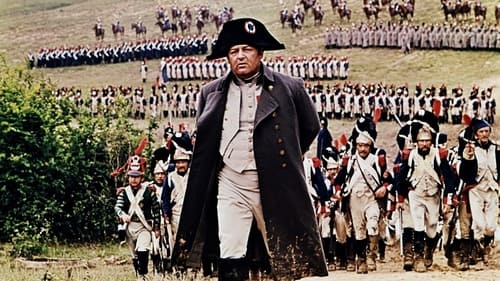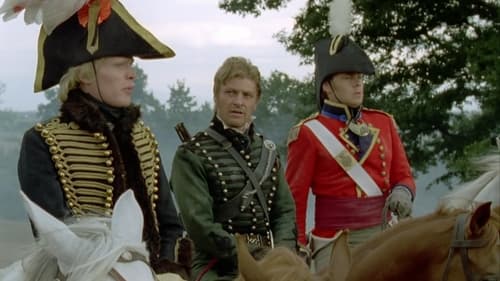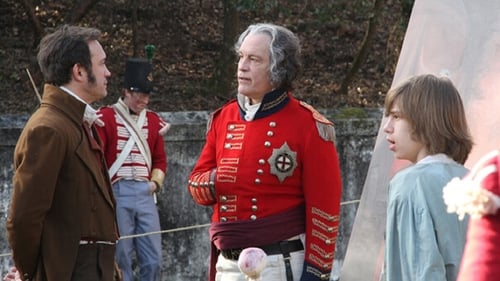Cavalry Charge: La Haie Sainte & Plancenoit - The French and Prussian Attacks (2011)
Género : Documental, Historia, Bélica
Tiempo de ejecución : 1H 35M
Sinopsis
Following on from Hougoumont and D'Erlon's Attack, Part III starts just as the great battle reaches its crisis point. Marshal Ney launched thousands of France's finest heavy cavalry against Wellington's thinning lines who had already taken a terrible battering on the Mont St Jean Ridge. Wave after wave of armoured horsemen broke against the steady squares of British, Dutch/Belgian and German troops. The crisis, however, took a further turn for the worse as the key bastion in Wellington's centre, the fortified farm of La Haie Sainte, fell to the French onslaught. The way to Brussels was now open and Wellington muttered, 'Give me Blucher or give me night'. With the situation looking bleaker by the second for Wellington and his troops, Napoleon fatefully hesitated to complete the coup de grace as the Prussians had closed in on his right flank at the Village of Plancenoit. Would the Young Guard be able to hold Blucher's men? There was all still to play for.

El 18 de junio de 1815 tuvo lugar la batalla de Waterloo, en la que el ejército de Napoleón Bonaparte fue derrotado por fuerzas británicas, holandesas y alemanas, comandadas por el duque de Wellington. Esta película recrea aquellos hechos que se produjeron con la presencia en la sombra de Luis XVIII.

Basado en la novela de Bernard Cornwell, "Sharpe's Waterloo" trae al rebelde oficial británico teniente coronel Richard Sharpe a su última batalla contra los franceses, en junio de 1815.

In David Grubin's NAPOLEON watch Napoleon's rise from obscurity to victories that made him a hero to the French people and convinced him he was destined for greatness. Learn of his love for Josephine Beauharnais, and his rise to Emperor. Witness his extraordinary achievements and ultimately his fall, his final battles, his exile to Elba, and his defeat at Waterloo. For nearly two decades he strode the world stage like a colossus -- loved and despised, venerated and feared. From his birth on the rugged island of Corsica to his final exile on the godforsaken island of St. Helena, NAPOLEON brings this extraordinary figure to life.

This film gives an overview of Napoleons return to France in 1815 before covering in detail the Battles of Ligny and Quatre Bras. Filmed on the Battlefields in Belgium using re-enaction footage expert Presenters follow the Emperors brilliant initial plan which however soon begins to fall apart due to flaws in the French staff, Napoleons arrogance and the courage and fighting ability of the Allied Troops. Both these battles deserve to be better known but they have been overshadowed by Waterloo the culmination of the Campaign

During the Napoleonic Wars the British Army realised that it needed skirmishers, as a result it raised 2 Rifle Regiments both armed with the icon Baker Rifle. This programme explains how the Riflemen of the 95th Rifles were dressed and equipped. It is an ideal accompaniment to our Series on the 95th Rifles.

Guerras napoleónicas (principios del XIX). El teniente de húsares del ejército napoleónico Armand Dhubert recibe la orden de arrestar al teniente Ferand por haber participado en un duelo. Ferand, encolerizado, se enfrenta con Dhubert, lo que provocará un nuevo duelo, esta vez entre ellos dos.

95th Rifles 1809 to Salamanca is the second DVD in 95th Rifles trilogy of films and part of The Peninsular Collection from BHTV . The DVD explores the history of the 95th Rifles, who were masters of the battlefield and particularly skilled in skirmishing. Held in high esteem by the French and Allies alike, they played a momentous role in the outcome of the Peninsular War. Following the events set out in the Salamanca DVD, this film serves as a prequel to explain the years leading up to the Battle of Salamanca, starting with the aftermath of Sir John Moore’s retreat to La Corunna in the winter of 1808/1809.

This film shows the kit and equipment that the 42nd of Foot, The Black Watch wore and used at Waterloo. The Battalion was in 9 Bde of Picton's 5th Division and fought at Quatre Bras and Waterloo. The 8 British Battalions in Picton's Division were all Peninsula Battalions and most probably the most relaible in Wellington's Army. Hence their use at Quatre Bras and their position at Waterloo. The Division lost 43% of its men as casualties at Waterloo including Picton himself, Wellington's greatest fighting general.

After the victory at Salamanca Wellington's Army had mixed fortunes and by the the winter of 1812/3 was back in Portugal. Wellington took advantage of the winter to re-equip and retrain his army for his final master stroke in Spain. In June 1813 Wellington launched his whole army in a rapid push NW towards the Spanish/French border outflanking the French. At Vittoria he beat the main French Army on 21st June and pushed the remainder into the Pyrenees on The French border. He was now able to prepare for the invasion of France. In all these actions and leading the Army were the Light Division containing the 3 Battalions of the 95th Rifles. It was during this period that they had some of their toughest and bloodiest actions that showed them to be an elite formation.

Due to the hostile terrain of the Iberian Peninsula Siege Warfare took on an importance here more than anywhere during the Napoleonic Wars. For the French in particular fortresses and fortified towns were the only places they could guarantee the safety of their logistics from the Spanish and Portuguese guerillas. If Wellington was going to liberate Portugal and Spain he would have to overcome these fortified locations. This film looks at the British and French experience during this period and uses the the great sieges of Ciudad Rodtigo and Badajoz to illustrate how both defence and attacks were carried out . The BHTV team use footage from Spain, re enactments, maps and models to bring this much neglected aspect of the Peninsula war to life.

This final part takes us through the dramatic events when Wellington’s Anglo-Dutch Army aided by Blucher’s Prussians defeat Napoleon. The French army was outfought and Napoleon was out-generaled by Wellington. At Wavre Grouchy beat the Prussian rearguard before retreating to France. Meanwhile, the Anglo-Dutch army counted the bloody cost of the previous days fighting while Wellington wrote his controversial Waterloo Dispatch and the vengeful Prussians pursued the French towards Paris, leading to Napoleon's abdication and the occupation of the city by the Allies.

Following on from Ligny and Quatre Bras, Part II starts by focusing on the concentration of the Allies on the ridge of Mont St Jean and the plans of the opposing armies. While the guns of the Grand Battery thundered in the centre, French columns bore down on the Hougoumont chateau and farm complex, which protected Wellington's flank held by the Guards and their German allies. Thus began an epic 'battle within a battle' that sucked away valuable troops from Napoleon's main attack, causing Wellington to declare that 'the battle turned on the closing of the gates at Hougoumont'.Meanwhile D'Erlons Corps attempted to bludgeon its way through Wellington's centre, not knowing that the British and Dutch line was in waiting on the reverse slope. Upon seeing the French advance, the British released a disciplined volley of musket fire that checked the French. A further brilliantly timed charge by the Household and Union Cavalry Brigades finally saw the French off.

Narra la historia de la ocupación de Portugal por las tropas napoleónicas a principios del siglo XIX. Realizado por Valeria Sarmiento, la viuda y editora de los filmes de Raúl Ruiz, partiendo de un proyecto póstumo de su marido.

Portrait of a Knight is a musical romance about the way in which historic ideals inform contemporary urban life. Rachel is a young archivist living and working in Wellington, New Zealand. Feeling alone and disconnected from life, she projects her romantic fantasies onto the paintings she loves, until one day her song brings Reginald - a Knight of the Realm - to life. His carefree innocence and zest for life begin to open Rachel up to the beauty around her, but the fates have a way of making trouble when miracles occur...

Major John Peel returns to England, following Napoleon's Waterloo defeat, and renews his acquaintance with Lucy Merrall, but she tells him she is engaged to be married. He later learns that, Cravens, the man she is to marry already has a wife. He also learns that Craven cleaned out Lucy's father in a crooked gambling game, and Lucy is paying the price to hold the family home together.

An entertaining look at life in Wellington, New Zealand in the 1960s, giving a colourful impression of Wellington city: hills, winding streets, busy people and strong winds.

Dealing heavily with perceptions of time, Aeon documents the urban cityscape as Wellington transforms through a zen-influenced eternal cycle of birth, life, death and rebirth within a 24-hour period.

An insider’s look into the gritty reality of building the local live music scene, Rock This Town brings to life the exciting history of rock music concerts in KW from the 1960s & ‘70s. Rock stars come and go but live music is here to stay!






